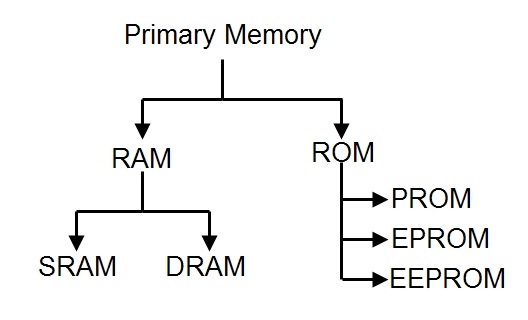Primary memory is also known as main memory or may also refer to “Internal memory.” and primary storage. All those types of computer memories that are directly accessed by the processor using data bus are called primary memory. That allows a processor to access stores running programs and currently processed data that stored in a memory location.
The use of memories is therefore mandatory in all systems using a microprocessor, including computers. An example of Primary memory is RAM and ROM that store programs. These memories are limited in capacity and manufactured by using integrated circuits (IC) or semiconductor device. Its speed of Data accessing is faster than secondary memory. It is more expensive than secondary memory.
When you turn on the computer, Generally CPU searches for essential codes in RAM to get it. Otherwise, it goes to ROM. Yes, they both chips collectively called primary memory in a computer system.

We’ll be covering the following topics in this tutorial:
Types of Primary Memory
RAM (Random Access Memory)
The Word “RAM” stands for “random access memory” or may also refer to short-term memory. It’s called “random” because you can read store data randomly at any time and from any physical location. It is a temporal storage memory. RAM is volatile that only retains all the data as long as the computer powered. It is the fastest type of memory. RAM stores the currently processed data from the CPU and sends them to the graphics unit.
There are generally two broad subcategories of RAM:
• Static RAM: Static RAM is the form of RAM and made with flip flops and used for primary storage are volatile. It retains data in latch as long as the computer powered. SRAM is more expensive and consumes more power than DRAM. It used as Cache Memory in a computer system. As technically, SRAM uses more transistors as compared to DRAM. It is faster compared to DRAM due to the latching arrangement, and they use 6 transistors per data bit as compared to DRAM, which uses one transistor per bit.
• Dynamic Random Access Memory (DRAM): It is another form of RAM used as Main Memory, its retains information in Capacitors for a short period (a few milliseconds) even though the computer powered. The Data is Refreshed Periodically to maintain in it. The DRAM is cheaper, but it can store much more information. Moreover, it is also slower and consumes less power than SRAM.
ROM (Read Only Memory)
ROM is the long-term internal memory. ROM is “Non-Volatile Memory” that retains data without the flow of electricity. ROM is an essential chip with permanently written data or programs. It is similar to the RAM that is accessed by the CPU. ROM comes with pre-written by the computer manufacturer to hold the instructions for booting-up the computer.
There is generally Three broad type of ROM:
• PROM(Programmable Read Only Memory): PROM stands for programmable ROM. It can be programmed only be done once and read many. Unlike ROM, PROMs retain their contents without the flow of electricity. PROM is also nonvolatile memory. The significant difference between a ROM and a PROM is that a ROM comes with pre-written by the computer manufacturer whereas PROM manufactured as blank memory. PROM can be programmed by PROM burner and by blowing internal fuses permanently.
• EPROM (Erasable Programmable Read Only Memory): EPROM is pronounced ee-prom. This memory type retains its contents until it exposed to intense ultraviolet light that clears its contents, making it possible to reprogram the memory.
• EEPROM (Electrically Erasable Programmable Read Only Memory): EEPROM can be burned (programmed) and erased by first electrical waves in a millisecond. A single byte of a data or the entire contents of device can be erased. To write or erase this memory type, you need a device called a PROM burner.
 Dinesh Thakur holds an B.C.A, MCDBA, MCSD certifications. Dinesh authors the hugely popular
Dinesh Thakur holds an B.C.A, MCDBA, MCSD certifications. Dinesh authors the hugely popular